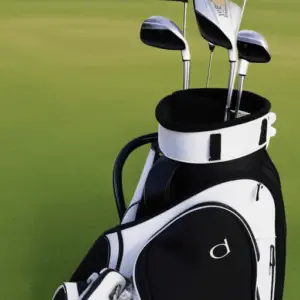Last Updated on May 26, 2023
Golfers are always looking for ways to improve their game, and one of the best tools they can have in their arsenal is a wedge. Whether you’re an experienced golfer or just getting started, knowing how to use a wedge in golf can be beneficial. In this blog post, we’ll explore what wedges are used for, the different types available on the market today, tips on using them effectively and the benefits of having a wedge as part of your club set. So if you want to learn more about improving your golfing skills with a wedge in golf, then keep reading.
Table of Contents:
- What Is a Wedge?
- Types of Wedges
- How to Use a Wedge
- Benefits of Using a Wedge
- FAQs in Relation to What is a Wedge in Golf
- Conclusion
What Is a Wedge?
A wedge is a type of golf club used to hit shots from short distances. Wedges are designed with higher lofts than other clubs, making them ideal for hitting high, soft shots that land softly on the green. They also have more bounce than other clubs, which helps prevent the clubhead from digging into the ground and allows it to glide through the turf more easily.
Types of Wedges
Golfers have a wide variety of wedges to choose from, each with its own unique purpose. The four main types of wedges are pitching, sand, lob and gap wedges.
Pitching Wedge
This wedge is typically the most versatile and commonly used in a golfer’s bag. It has the lowest loft angle out of all the other wedges and can be used for shots ranging from 30-100 yards away from the green. Pitching Wedges are also great for hitting high-trajectory shots that land softly on the green or stop quickly when they hit it.
Sand Wedge
Sand Wedges have more loft than pitching wedges which makes them perfect for getting out of bunkers or sand traps around greenside areas. They usually feature heavy sole designs that help golfers dig into soft surfaces like sand without digging too deep into hard surfaces like grass or dirt. Additionally, they provide extra spin control so you can get your ball close to where you want it to go, even if you don’t make perfect contact with it every time.
Lob Wedge
Lob Wedges are designed specifically for short-distance shots near greenside areas, such as chips and pitches around 50-75 yards away from the hole. These clubs usually feature higher lofts than other types of wedges, which allows golfers to hit high trajectories that land softly on their target area without rolling too far past it once they reach there.
Gap Wedges
Gap Wedges are between a pitching wedge and a sand wedge in terms of loft angle (usually 48-54 degrees). As such, these clubs can be used for both full swings off fairways as well as shorter approach shots around greenside areas, depending on how much power you put behind them. Gap wedges also offer more versatility than either type alone because they bridge the gap between two types of play styles, allowing golfers to tailor their game based on what kind of shot they need at any given moment.
How to Use a Wedge

Using a wedge is an important part of any golfer’s game. A wedge is a club with a lofted face that helps you get the ball into the air and close to the hole. Using it correctly can help you lower your scores and improve your overall golf game.
The first step in using a wedge effectively is getting into the correct stance. Your feet should be shoulder-width apart, with your weight evenly distributed between them. You should also ensure that your arms are relaxed and not too far away from your body, giving you more control over the club head during your swing.
When swinging with a wedge, it’s important to remember that less power is needed than when using other clubs such as drivers or irons. This means you don’t need to take such a big backswing or put so much effort into hitting the ball hard; instead, focus on making contact with the ball cleanly and accurately for maximum distance control. To do this, try taking shorter swings while keeping good posture throughout – think of brushing off dirt rather than smashing through rocks.
To maximise spin rate, it is essential that you hit down onto the ball at impact instead of sweeping across it like an iron shot. When executed correctly, this will create a backspin which increases accuracy when playing around greenside bunkers or hazards, as well as better stopping power on approach shots close to pins/flags and so forth.
Finally, remember to practice regularly with wedges; even 20 minutes per day can make all the difference. Make sure each time you practice different types of shots, such as chips from tight lies around greenside bunkers/hazards or full swings from longer distances out in fairways etc., so that eventually, no situation feels unfamiliar come tournament time.
Benefits of Using a Wedge

Using a wedge in your golf game can provide you with several advantages. The most notable of these is increased accuracy and distance control. With the right technique, you can use a wedge to hit shots that are more accurate than those taken with other clubs. This means that when playing on a course with tight fairways or hazards, using a wedge can be invaluable for avoiding trouble spots and staying out of the rough.
Distance control is another major benefit of using wedges in your game. Wedges have higher lofts than other clubs, which makes them ideal for hitting shorter shots around the green, where precision is key. By adjusting your stance and swing speed accordingly, you can easily adjust how far each shot goes without sacrificing accuracy or consistency from one shot to the next.
Wedges also come in handy for getting out of difficult lies such as sand traps or deep roughs near greenside bunkers. Because they have high loft angles, wedges are better suited for lifting balls up and over obstacles like these compared to lower-lofted irons or woods, which tend to dig into the ground instead of propelling balls forward off the surface due to their lower trajectory arcs at impact points.
Finally, wedges offer an advantage over putters because they allow players greater versatility when faced with different types of putting surfaces, such as sloped greens or fast-paced ones requiring more power behind each stroke if needed. This gives players more options when trying to navigate tricky pin placements while still maintaining accuracy throughout their rounds by utilising different techniques depending on what type of terrain they are playing on.
FAQs in Relation to What is a Wedge in Golf
What is a wedge used for in golf?
It has a loft angle between 46-64 degrees, making it one of the most versatile clubs in the bag. Wedges are typically used for short approach shots around the green, as well as bunker play and chip shots. They can also be used for full-swing shots from further distances when more spin or control is needed. Wedges come in many different varieties, such as lob wedges, gap wedges, sand wedges and pitching wedges which all have their own specific uses depending on the situation at hand.
What is the difference between wedges and irons?
Wedges and irons are both types of golf clubs, but they have different uses. Wedges are typically used for shots that require more loft or spin, such as getting out of a bunker or hitting a high approach shot. Irons are generally used for long-distance shots, such as teeing off on the fairway or hitting an iron to the green. The key difference between wedges and irons is that wedges have more loft than irons, meaning they can hit higher and softer shots with less effort from the golfer. Additionally, wedges usually feature wider soles which help them dig into the sand and rough surfaces easier than irons.
What loft is a wedge?
A wedge is a type of golf club with the highest loft angle, ranging from 48 to 64 degrees. The higher the loft angle, the more vertical trajectory and spin on your shot. A standard pitching wedge will have a loft angle of around 46-48 degrees, while a sand wedge will usually have 56-58 degrees of loft. Lob wedges can range up to 64 degrees or even higher in some cases. Generally speaking, the higher the loft angle, the easier it is to hit shots with greater height and spin control and less distance than lower lofts would provide.
Conclusion
In conclusion, a wedge in golf is an essential club to have in your bag. It can be used for many different shots and can help you get out of tough spots on the course. Knowing how to use it properly will give you more control over your game and make you a better golfer overall. So if you’re looking to take your game up a notch, don’t forget about the importance of having a wedge in golf.



